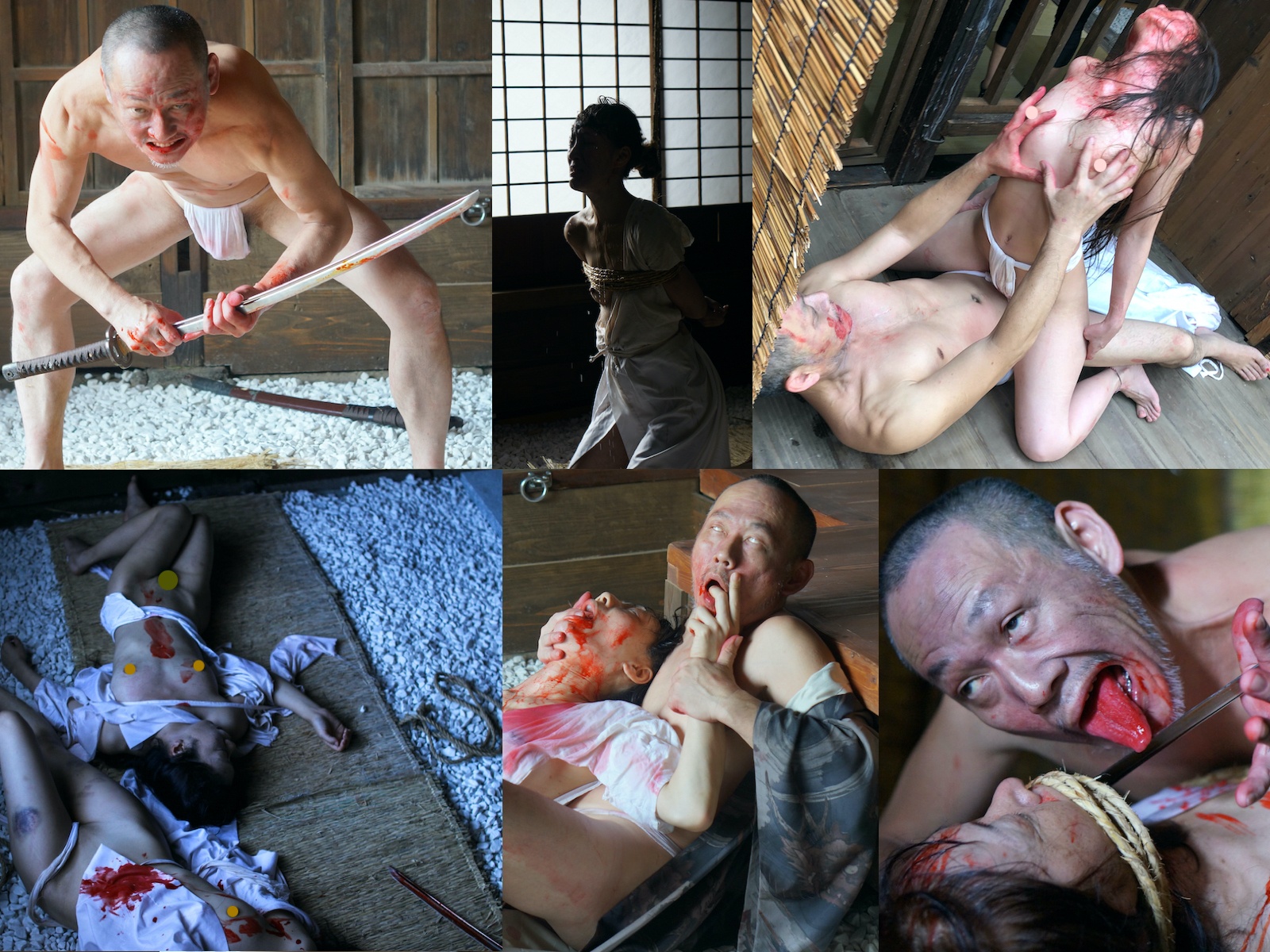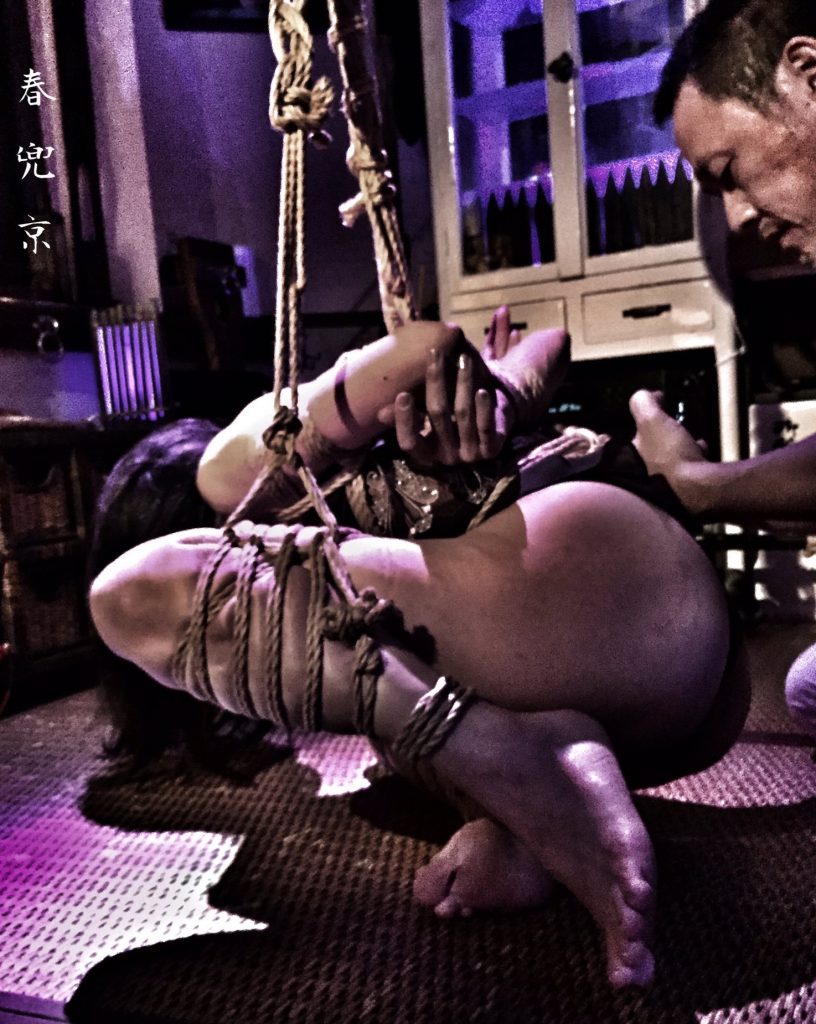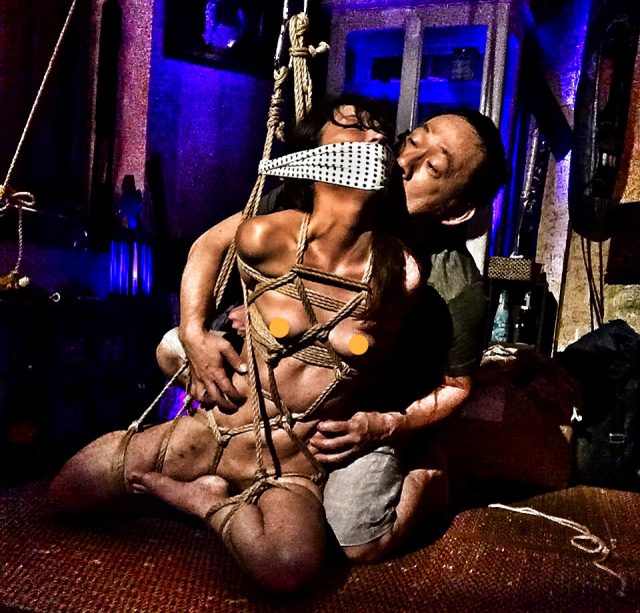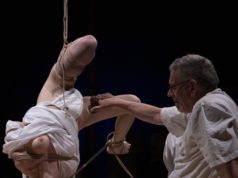Welcome to the scene. Like a Greek or Shakespearian tragedy, the flickering images of this desperate act of human depravity will not leave your future nightmares.
Japan is in the dying of its feudal period. Fiefdoms had traditionally fought for control, for wealth, for trade, for influence. But now it is Haihan–chiken and the imperial edict has been decreed. If the local daimyō does not acquiesce in absolute servitude to Meiji–tennō, the sole emperor of the one nation, resistance will be dealt with harshly.
One such fictional battle has ended in a decisive victory for Meiji–taitei. His army has slaughtered or captured the most loyal of the daimyō’s forces. Now, inside the castle, the last of his loyal guard are being systematically picked off, until only he, his wife, children, harem and household are left inside the Koukyu inner fortress.
In his fear and rage a madness takes him, wild and demonic. He cannot allow his closest to be taken and punished, humiliated, gang raped, tortured and then tied by Samurai jailers to be killed by a slow, malicious death.
Losing control of his mind, he binds those closest to him with simple grass Aranawa, and a bloodbath ensues. The boys may escape mercifully with a quick death. The girls and women are cut and stabbed into every orifice so the agents of his adversary cannot use them without being bloodied themselves. The sanguine stench. The terrified screams of horrific suffering. The gargling of dying breaths. The floors and walls splattered with blood and entrails.
This is an imagined event of such magnitude and emotion, in part showing the metal of the defeated to his victorious foe, in part denying their despicable pleasures of revenge. Naked and caked with the blood of his butchered loved ones, he finally takes his sword, drops to his knees, rotates the tip of the blade in towards his stomach, plunges it deep, and grimaces through the pain, drawing it laterally through his guts as he commits Seppuku.
Welcome to the nonprofessional and the conjectural research of Haru–to–Kyou, something he is loath to perform or teach, save the techniques should end at the hands of narcissistic fools, not comprehending the depth of historical context.
This is dangerous Kinbaku. Shibari rope handling designed to kill. It makes the Semenawa we see in the west look more like tickling. In the hands of a skilled expert with all the anatomical knowledge, this Shibari will take a life over the period of a day – a drawn out, lingering, painful death akin to crucifixion. In the hands of a novice, experimenting, picking up inspiration from detached media of how the ties may function, manslaughter might occur in seconds. Be warned in the strongest of terms.
The vast bulk of what is currently understood about the historical martial uses of rope bondage have only really been researched over the past 15 years since Akechi Denki’s death, when individuals such as Haru–to–Kyou began exploring how these ties might have been applied.
But it is also imperative to put all research and knowledge of the martial use of rope bondage into a framework. Our modern interest derives out of the sadomasochistic and erotic use, and is the driving force to dig into historical use. How those old ties would have been made, and what their finite functions were, are still the stuff of guesswork, supposition and deduction.
Travelling the length and breadth of Japan, visiting museums, historical residences, archives and working from ancient paintings, drawings and notations, Haru–to–Kyou believes he has evolved and refined several ties back into existence.
Unknown that this would be one of the last days of Denjiro Sakurada’s legendary Theatre Poo, I took some instruction with a fellow student and friend, Kazumi Osada. The tying was demonstrated to us by both Haru–to–Kyou and Koyuki san, his student, and an old personal friend I had not seen since she was working at Bar Mitsu, Shinjuku. For models, we used the lovely ladies of Haru–to–Kyou’s Koukyu team.
Of note are certain factors, including the manipulation of the victim’s body. Haru–to–Kyou demonstrated how to tie a person using only their own limbs and joints, and no rope. Elements we should be concerned with in modern tying, like wrist drop and compressed nerves, with this type of ancient Shibari, of course, would have been the least of the poor victim’s concerns.
Some ties were clearly intended for the purposes of rape and sexual violation. But interestingly, few knots were used, and instead very cunning hitches and lashings. With so many prisoners, reprehensible jailers would probably have developed new methods to kill them, as slowly as possible, often making the death appear accidental, and at least one prison official later documented this Shibari. This then became the catalyst for interest from, e.g. Muira Takumi, and then by association, Akechi and Haru–to–Kyou.
But we also have to put into context the feudal Edo period. Think of it in terms connected to the low value of human life, and the barbarism of man; the Mongol armies of Genghis Khan, the Spanish inquisition, etc. There are so many historical instances of crimes against humanity, torture and depraved suffering during the same period, all over the world. In our modern kink scene, we can easily make the connection to see how this could have influenced characters such as the Marquis de Sade, etc. and how sexual depravity can blend with references to inhumanity.

Assisted once again by the ever–conversant Yuki Sakurai, I began by asking Haru–to–Kyou to explain his name, background, and his earliest memories associated with Kinbaku.
Haru–to–Kyou: “I was born on February 6th, 1966 in Osaka. If I can call it Kinbaku, my first experience was when I was about 8 or 9 nine years old when I was in the third grade of primary school. I tied up my female friend and put her in a closet.”
His nickname ‘Haru–to–Kyou’ is unusual, even for Japanese, and is derived from parts of the names of his two sons, Haru–xx and Kyou–xx shortened to Haru–to–Kyou.
I next asked what the circumstances were of how he became the owner of the bar BUG in Ikebukuro, Tokyo. Already working there, he took over managing it in June 2002 from Kanna when s/he left to open Succubus, and then gave regular rope bondage lessons. We asked who Haru–to–Kyou learned from, and better detail of this time period for our understanding.
Haru–to–Kyou: “The owner of BUG was a personal acquaintance. However, BUG was a fetish bar, not a happening bar. We had only about four fetish bars in the whole of Japan at that time.
BUG’s owner asked me to take over the management in 2002 in order to increase sales. It was successful, so I bought BUG from the owner.
After about a decade, the media started to call BUG a happening bar. Fetish bars accept many preferences, for example, flashing, cutting, choking, piercing, whipping, etc. On the other hand, a happening bar’s aim is for group sex – swingers.
15 years later, so many happening bars opened. Customers from happening bars started to come to the fetish bars and the morals became very disturbed and confused. So, I chose to close down BUG.
I took a break for 4 years, and then opened Haru BAR with the idea to help older ladies who had given up on sex. Haru BAR is also in Ikebukuro, and mainly caters for Kinbaku. The original concept was to recreate those fun times again for richer business women over 50 years of age, possibly into their 70s. But they rarely come. It is mostly younger ladies who come, in their 30s and 40s.
Originally, my primary job was as a musician, so I was put in charge of the music for Akechi Denki when he performed a show in BUG. He had been arrested due to a copyright violation because he was using the music of Sakamoto Ryūichi. This was during the period of the ultra–right–wing Governor of Tokyo Ishihara Shintarō, who was trying to clean up the red–light district of Kabukichō. So, I provided Akechi san with music for his show in BUG, Ikebukuro. That was our first encounter.
I was already doing Kinbaku at that time. But when I saw Akechi san’s Shibari, I started to think that I wanted to learn it properly. However, he did not teach me. So, I was just beside Akechi san like an assistant to learn just by watching. In time, we started to research old ties together, and after he died, I continued researching.”
After Akechi’s unfortunate death, Haru–to–Kyou became the ‘second generation’ to Miura Takumi’s Bakuyukai in September 2006, which had been formulated as the first ever dōjō approach to rope bondage to simplify the teaching of basic Shibari tying.
Haru–to–Kyou: “Actually, I do not know what ‘vice–president of the second generation’ means. In Judo, we have the first level, the second level, the third level and so on. We have a representative and a vice–president in order to express positions. The top; the original representative was Akechi san. After he passed away, Miura san became the second representative. But I think now that Gaijin can enjoy Haru–to–Kyou STUDIO. In fact, only the other day an Italian came.”
About a year ago he opened the studio, but it was badly damaged by Typhoon Hagibis in October. We asked how the recovery was going.
Haru–to–Kyou: “The studio is a house built in the Edo period that I bought. The roof was completely lost due to the typhoon, and we are repairing it now. It is in Kyonan in Chiba Prefecture.”
We were then presented with the incredible pictures of the graphic depiction of a fictive feudal lord reenacting his final moments succumbing to the Haihan–chiken edict, graphically described in the opening paragraphs of this interview.
Haru–to–Kyou: “My rope is a little different than others. I am specializing in torture rope. This is ropework that was used to kill criminals in the Edo period. For example, we have Torinawa–jutsu and Hojō–jutsu.
You know, we had Haihan–chiken (the imperial proclamation of the Meiji Restoration) to start the Meiji period. In the west at this time there could be only one King (or Queen) per country. But Japan was a country which still had many Kings. However, Haihan–chiken was enforced and every local King who resisted committed Seppuku (Hara–kiri suicide). In the photographs I am acting out the make–believe story of a man who committed seppuku, with a little eroticism. It is the drama of a man who kills all of his family and finally commits suicide.
I would like to hold a photo exhibition to show this story. This local king is the main character. He kills many people and finally commits suicide. What I want to show the most is the Tori–nawa.
Tori–nawa is Shibari that was used by jailers during the Edo period. It was made with Aranawa grass rope, and not Asanawa. Asanawa tightens when it is made wet, but Aranawa is made of straw so it does not tighten when it becomes wet.
This document is a statement of Haihan–chiken in the Edo period.
Tori–nawa, is also called Hobaku–nawa or Hojō–nawa. Its form flows down all the way, or tie joins in a method called Sayou–nawa (作用縄), because it functions (Sayou) with a view to killing the victim painfully and slowly.
Normally, Shibari just wraps and tightens via knots, but Sayou–nawa winds up and tensions with Kannuki latches, and applies a load from there. It is Koten Kinbaku, (古典緊縛) an ancient (classical) tight binding method.
What I want to show the most is the Shibari that was used by jailers. These jailers were Samurai, and they had worked as jailers for hundreds of years. They started to think of how to kill criminals because it is troublesome to put them on trial. So, this is Shibari that these jailers created over those hundreds of years. During my research, when I looked into documentation, death due to Kinbaku is the most common.
There are so many methods. Not only hanging by the neck because it will be easily found out. Instead, they tied joints. I will show you some. Do you know Taijutsu malicious (tying) technique? Cruel, brutal, barbaric – the classical form of martial art?”
Note: Asanawa (麻縄) is generally stated as ‘hemp rope’, but because the Japanese Kanji character 麻 can mean either Cannabis sativa; the hemp plant or fibre, or linen, flax and/or jute it can appear extremely confusing. However, considering Haru–to–Kyou’s statement regarding wet shrinkage, hemp rope does not shrink, whereas jute does. Ergo, Asanawa is made from jute, and it is a fallacy to believe it is made from hemp as we know the plant fibre in the west.
Furthermore, many of these old ties demonstrated by Haru–to–Kyou, and practiced by Kazumi san and myself in instruction may not have been widely disseminated throughout the feudal Han administrative divisions of pre–Meiji Japan. Some indeed would have been kept closely guarded technical secrets, ultimately, to prevent development of ways to escape them.
Haru–to–Kyou then demonstrated on one of his willing lady models how to manipulate and lock the joints between the limbs to immobilize, and effectively tie her without a single piece of rope. He explained how he had learned to do sport massage, because he was boxing since 11–years of age, and had to massage his superiors, and how this helped in understanding how to exploit human anatomy.
Haru–to–Kyou: “I have been to the old Satsuma–han in Kagoshima prefecture, Chōshū–han in Yamaguchi prefecture, Tosa–han in Kouchi prefecture, and Aizu–han in Fukusihma prefecture. They all played an active part in the late Edo period, and I’m researching them by visiting old houses where they have old documents. National associations want those documents, but the owners keep hold of them because they are their heirlooms. They won’t even let us take photos. So, I go there, see them, and listen to their stories. And then I create images from the old monochrome drawings.
What I want to do now is to let people remember and know criminal situations in the late Edo period. Now I’m visiting many Japanese castles with Koyuki to take photos in the museums and collect documentation. I’m recording them in photos and writings.
I was interested from the very beginning. My aunt is from Kagoshima Prefecture, so I first went to old Samurai residences there about 30 years ago. I started to specifically research around the year 2000. So, I’ve been doing it for about 20 years now. Back then, a representative of Akechi was also researching it. Then we started to do it together, independently of Miura san. But Akechi san was more of a really kinky guy who found it kind of interesting.
The photo exhibition will be held in September after the Tokyo 2020 Olympics. I would like to reproduce what we have researched so far. But I think I cannot perform it on a stage because it is too crazy.
I do not make films about it is because I tend to lighten up. I tried making some movies, but there is no real force.”
I then specifically wanted to ask about my own personal perception, based upon multiple interactions with various Japanese Kinbakushi over the years, and observing how Kinbaku–Shibari–rope bondage may have begun a diversification beginning with the Bakuyukai from the late 1990s.
From all my observations, before, it appeared more of a private, secret activity only exposed through Hentai as sexual perversion, when the girl was the focus of attention. Afterwards, we have seen different people try to make rope bondage into a martial art, into creative art, into schools with their own dogmatic approaches, into the copying and cloning of the teachers’ styles, etc.
Sadly, there appears to be far more focused on the simpler, easier side to teach: the knots, ties, structures, suspension, transitions – the basics, and very minimal consideration for the complex advanced elements: psychological subjection, emotional intelligence, anatomical manipulation, affinity and empathic context, etc.
Haru–to–Kyou: “I am already old as a Kinbakushi. There were only about twenty Kinbakushi in the early 2000s. But now there are hundreds.
I have about 7,000 followers for my Haru–to–Kyou Twitter account, and this Haru–to–Kyou is my ideal model. I upload pictures like the ones you see with your article, but these are all my ideal model and he is my fictional character. There are many requests for me to do a performance show, but I’ve never done one. Sometimes I upload short videos on Twitter, but there are almost no files, only pictures.
But in fact, it’s also a problem in Japan, not just in the west. I do not want people to have an accident with rope bondage. In particular, the rope I am studying is a killing rope, so the main thing is to study together instead of teaching. I teach just the basic things, and that is safe modern Kinbaku. The other problem is that often it is mainly the dangerous narcissistic people that want do the martial art approach.”
I asked how he felt about the way rope bondage had grown into a cult outside of Japan, with approximately 40,000 active participants, when 20 years ago, it was probably a few hundred at maximum.
Haru–to–Kyou: “I agree with you. Conversely, the best people are now starting to stay underground. I saw on the Internet Westerners doing Kinbaku, and I feel the love from them more than Japanese people doing it nowadays. I don’t think about cultural misappropriation of Kinbaku to foreign countries, just like SONY is not Japanese culture anymore. I don’t think it’s a sad thing. Probably it has changed into a different field, so we will just research and keep it secret on our side.
I think there is no difference between Japanese and Western attitudes and approaches regarding sadomasochism and eroticism if the historical backgrounds are the same. The same can also be said for Kinbaku. For example, Japanese people are shy and they cannot dance even if they are asked to. As you can see from Japanese people’s Kinbaku performances, they are a bit shy.”








